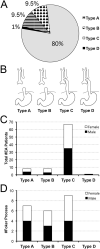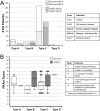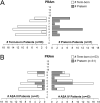From the Ground Up: Esophageal Atresia Types, Disease Severity Stratification and Survival Rates at a Single Institution
- PMID: 35356503
- PMCID: PMC8959439
- DOI: 10.3389/fsurg.2022.799052
From the Ground Up: Esophageal Atresia Types, Disease Severity Stratification and Survival Rates at a Single Institution
Abstract
Esophageal atresia (EA), although a rare congenital anomaly, represents one of the most common gastrointestinal birth defects. There is a gap in our knowledge regarding the impact of perioperative critical care in infants born with EA. This study addresses EA types, disease severity stratification, and mortality in a retrospective cohort at a single institution. Institutional Review Board approved our retrospective cross-sectional study of term-born (n = 53) and premature infants (28-37 weeks of gestation; n = 31) that underwent primary surgical repair of EA at a single institution from 2009-2020. Demographic and clinical data were obtained from the electronic medical record, Powerchart (Cerner, London, UK). Patients were categorized by (i) sex, (ii) gestational age at birth, (iii) types of EA (in relation to respiratory tract anomalies), (iv) co-occurring congenital anomalies, (v) severity of disease (viz. American Society of Anesthesiologists (ASA) and Pediatric Risk Assessment (PRAm) scores), (vi) type of surgical repair for EA (primary anastomosis vs. Foker process), and (vii) survival rate classification using Spitz and Waterston scores. Data were presented as numerical sums and percentages. The frequency of anatomical types of EA in our cohort parallels that of the literature: 9.5% (8/84) type A, 9.5% (8/84) type B, 80% (67/84) type C, and 1% (1/84) type D. Long-gap EA accounts for 88% (7/8) type A, 75% (6/8) type B, and 13% (9/67) type C in the cohort studied. Our novel results show a nearly equal distribution of sex per each EA type, and gestational age (term-born vs. premature) by anatomical EA type. PRAm scoring showed a wider range of disease severity (3-9) than ASA scores (III and IV). The survival rate in our EA cohort dramatically increased in comparison to the literature in previous decades. This retrospective analysis at a single institution shows incidence of EA per sex and gestational status for anatomical types (EA type A-D) and by surgical approach (primary anastomosis vs. Foker process for short-gap vs. long-gap EA, respectively). Despite its wider range, PRAm score was not more useful in predicting disease severity in comparison to ASA score. Increased survival rates over the last decade suggest a potential need to assess unique operative and perioperative risks in this unique population of patients. Presented findings also represent a foundation for future clinical studies of outcomes in infants born with EA.
Keywords: ASA; EA; LGEA; PRAm; mortality; premature; term; term-born infant.
Copyright © 2022 Evanovich, Wang, Zendejas, Jennings and Bajic.
Conflict of interest statement
The authors declare that the research was conducted in the absence of any commercial or financial relationships that could be construed as a potential conflict of interest.
Figures





Similar articles
-
Retrospective analysis of neurological findings in esophageal atresia: Allostatic load of disease complexity, cumulative sedation, and anesthesia exposure.Birth Defects Res. 2024 Jan;116(1):e2269. doi: 10.1002/bdr2.2269. Epub 2023 Nov 7. Birth Defects Res. 2024. PMID: 37936552
-
Foker Technique for the Management of Pure Esophageal Atresia: Long-Term Outcomes at a Single Institution.Eur J Pediatr Surg. 2016 Apr;26(2):215-8. doi: 10.1055/s-0035-1546757. Epub 2015 Mar 16. Eur J Pediatr Surg. 2016. PMID: 25774957
-
Management of long-gap esophageal atresia.Transl Pediatr. 2024 Feb 29;13(2):329-342. doi: 10.21037/tp-23-453. Epub 2024 Feb 27. Transl Pediatr. 2024. PMID: 38455743 Free PMC article. Review.
-
Long-Gap Esophageal Atresia Is a Unique Entity within the Esophageal Atresia Defect Spectrum.Neonatology. 2017;111(2):140-144. doi: 10.1159/000449241. Epub 2016 Oct 19. Neonatology. 2017. PMID: 27756070 Free PMC article.
-
Current knowledge on esophageal atresia.World J Gastroenterol. 2012 Jul 28;18(28):3662-72. doi: 10.3748/wjg.v18.i28.3662. World J Gastroenterol. 2012. PMID: 22851858 Free PMC article. Review.
Cited by
-
Neurodevelopment at 10 months and 2-3 years old after early and prolonged anaesthesia in infancy: General Anaesthesia & Brain Activity study (GABA) secondary analysis.BJA Open. 2025 Mar 10;14:100383. doi: 10.1016/j.bjao.2025.100383. eCollection 2025 Jun. BJA Open. 2025. PMID: 40129613 Free PMC article.
-
Retrospective analysis of early neurodevelopmental outcomes after esophageal atresia repair at a single institution: short-gap vs. long-gap defect.Front Pediatr. 2025 Feb 28;13:1527880. doi: 10.3389/fped.2025.1527880. eCollection 2025. Front Pediatr. 2025. PMID: 40092572 Free PMC article.
-
Missed Proximal Tracheoesophageal Fistula (TEF) in a Neonate with Type D Esophageal Atresia.European J Pediatr Surg Rep. 2024 Jan 10;12(1):e4-e6. doi: 10.1055/a-2227-6389. eCollection 2024 Jan. European J Pediatr Surg Rep. 2024. PMID: 38214009 Free PMC article.
-
Tactile sensitivity and motor coordination in infancy: Effect of age, prior surgery, anaesthesia & critical illness.PLoS One. 2022 Dec 30;17(12):e0279705. doi: 10.1371/journal.pone.0279705. eCollection 2022. PLoS One. 2022. PMID: 36584108 Free PMC article.
-
Novel Mammillary Body Manual Segmentation: Application for Quantitative MRI Analysis of Critically Ill Infants.Clin Neuroimaging (Hoboken). 2025;2(1):e70011. doi: 10.1002/neo2.70011. Epub 2025 Feb 26. Clin Neuroimaging (Hoboken). 2025. PMID: 40438140 Free PMC article.
References
-
- Moore KL, Persaud TVN, Torchia MG. Alimentary System. In Moore KL, Persaud TVN, Torchia MG, editors. The Developing Human: Clinically Oriented Embryology. London: Elsevier India; (2012), p. 193–221. Available online at: https://www.elsevier.com/books/the-developing-human-clinically-oriented-...
-
- Gross RE. The Surgery of Infancy and Childhood: its principles and techniques. Philadelphia, London: WB Saunders; (1953).
Grants and funding
LinkOut - more resources
Full Text Sources
Miscellaneous

